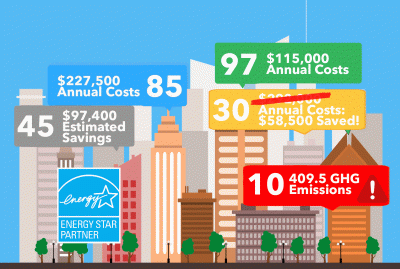Energy Benchmarking
Energy benchmarking is a process that compares a building’s energy usage (electricity, water, gas) to that of similar buildings to identify areas for improvement and optimize energy usage. For many facilities, you can rate their energy performance on a scale of 1–100 relative to similar buildings nationwide. This rating is similar to the Miles Per Gallon (MPG) rating of a car in that it tells you how energy efficient a particular building is. A rating of 50 indicates that the building, from an energy consumption standpoint, performs better than 50% of all similar buildings nationwide, while a rating of 75 indicates that the building performs better than 75% of all similar buildings nationwide. Conversely, seeing that a building uses more energy than 80 or 90% of similar buildings can be a convincing indicator for building improvements.
In 2021 there were 34 Energy Benchmarking Laws or Ordinances. Today, in 2024, there are now 56 Energy Benchmarking Laws nationwide. These laws require commercial and multi-family buildings to track their energy usage and report it to regulatory bodies. By complying with these laws, businesses can avoid penalties and fines and also access opportunities for energy incentives and grants.
Use this form to get started on your Energy Benchmark Compliance by registering your FREE account on VertPro®:
At Vert Energy Group, we understand that energy benchmarking can be a complex and time-consuming process for businesses. That’s why we offer a suite of services that simplify the process and save businesses time and money. Our SaaS platform, VertPro®, is designed to streamline energy benchmarking by automating data collection and analysis. VertPro® Powered by Vert Energy Group, is easy to use and provides businesses with the insights they need to optimize energy usage and reduce costs. Our team of experts is also available to provide support and guidance throughout the energy benchmarking process.
Whether you are a single-property manager or a multi-property manager, energy benchmarking is a valuable tool for optimizing energy usage and reducing costs. Contact Vert Energy Group today to learn more about our energy benchmarking services and how we can help you comply with energy regulations while saving money on energy costs.
Benchmarking is a simple energy management tool that allows you to track and assess energy and water consumption across your entire portfolio of buildings. Whether you own, manage, or hold properties for investment, benchmarking will allow you to set investment priorities, identify underperforming buildings, verify efficiency improvements, and receive EPA recognition for superior energy performance.
Energy Star’s Portfolio Manager is one of the most commonly used tools for benchmarking your building’s energy use. Among others include Go Solar California and CalARCH which offered simplified tools for comparing facilities.
Benchmarking for Multiple Properties
For multi-property managers, the benefits of energy benchmarking are even greater. With a portfolio of buildings, benchmarking provides an overview of energy consumption across all properties, enabling managers to identify trends and patterns that can help them optimize energy usage and reduce costs. By benchmarking energy usage across their entire portfolio, multi-property managers can prioritize investments, identify underperforming buildings, verify efficiency improvements, and receive recognition for superior energy performance.
If you own or manage a portfolio of several properties, energy benchmarking can aid in the decision when considering which building(s) need investment first. We can assist in creating a database that is automatically updated each month so you can compare and know which buildings are operating more or less efficiently. Here is an example of the potential your properties might have:

